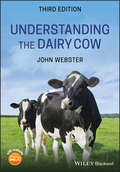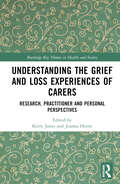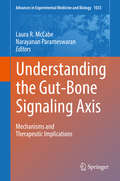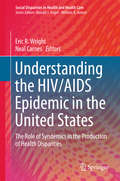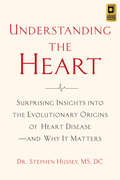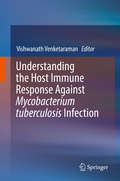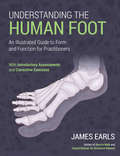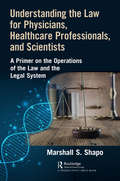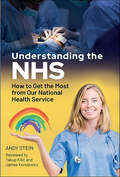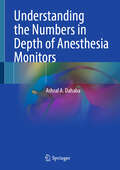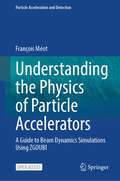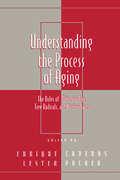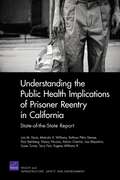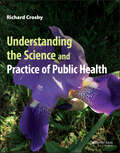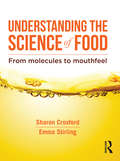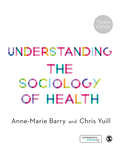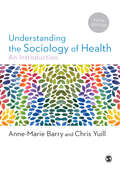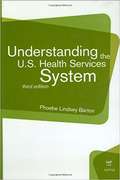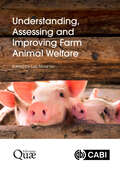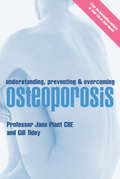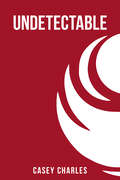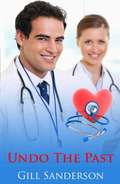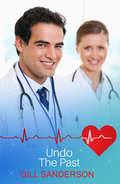- Table View
- List View
Understanding the Dairy Cow
by John WebsterA comprehensive and thoroughly revised text on dairy science that contains information on the most recent developments The fully updated third edition of Understanding the Dairy Cow explores the scientific principles that provide a foundation for understanding the animal’s body system. The comprehensive text also reveals how to properly manage dairy cattle with economic efficiency whilst taking into consideration the cow’s welfare. The revised new edition contains expanded coverage on topics including insight into cow behaviour and welfare, genetic selection indices, new strategies for control of mastitis and lameness and information on the overworked cow. It also contains the most recent developments in breeding, nutrition and management. Is an authoritative text on the dairy cow that covers a wide-ranging subject area including the science, disease and husbandry Presents the information and knowledge necessary for the efficient and humane management of cows Includes expanded coverage on a variety of topics such as cow behaviour and welfare, and genetic selection indices Highlights major new developments in the field Covering both the basics and recent developments in dairy science, Understanding the Dairy Cow 3rd Edition is ideal for students in agriculture and veterinary science and for professionals working in the complex business of dairy farming.
Understanding the Grief and Loss Experiences of Carers: Research, Practitioner and Personal Perspectives (Routledge Key Themes in Health and Society)
by Kerry Jones Joanna HorneThis book draws on recent research and cutting-edge ideas about bereavement and carers’ experiences across the life course to explore carers’ experience of loss and discuss their specific needs prior and or following the death of those they care for.Whether care provided is related to a long term or life limiting condition, many carers experience a multitude of losses including indefinite loss characterised by the loss of a taken-for-granted future, and an inability to plan for the future. Carers may also experience anticipatory grief as multiple losses such as companionship, personal freedom, and control manifest. While many carers are dedicated and committed to their role, they are subject to burnout and disenfranchised grief. When the role of caregiver ends as a result of the death of those cared for, this can represent a major change and a period of significant adjustment for carers leading to a range of emotions experienced.This book presents and discusses research findings, practitioner perspectives, and a wealth of personal accounts to illuminate this vital but neglected area and extend our understanding of loss for carers across the life course. This interdisciplinary and interprofessional volume brings together authors from a wide range of backgrounds, including carers themselves. It is an important contribution to the burgeoning literature around the role and experiences of carers and will interest academics, students and practitioners in health and social care, counselling, and psychology with an interest in loss and bereavement.
Understanding the Gut-Bone Signaling Axis
by Laura R. McCabe Narayanan ParameswaranThis is the first book compiling current research on the gut-bone signaling axis and its implications in the pathophysiology of GI and bone diseases. Rather than focusing on a single mechanism, this book provides the reader with a broad view on gut-bone signaling and the most up-to-date information in this rapidly growing area. The volume is also unique in that it looks at what is known about GI diseases affecting bone and then examines the role of the microbiome and its modulation by pre and probiotics to treat bone disease, placing this topic within the context of gut-bone signaling pathways. Understanding the Gut-Bone Signaling Axis will thus provide an understanding of how various therapies could be applied to this area.
Understanding the HIV/AIDS Epidemic in the United States
by Eric R. Wright Neal CarnesThis book examines the HIV/AIDS epidemic in the United States using the concept of syndemics to contextualize the risk of both well-known, and a few lesser-known, subpopulations that experience disproportionately high rates of HIV and/or AIDS within the United States. Since discovery, HIV/AIDS has exposed a number of social, psychological, and biological aspects of disease transmission. The concept of "syndemics," or "synergistically interacting epidemics" has emerged as a powerful framework for understanding both the epidemiological patterns and the myriad of problems associated with HIV/AIDS around the world and within the United States. The book considers the disparities in HIV/AIDS in relation to social aspects, risk behavior and critical illness comorbidities. It updates and enhances our understanding of the HIV/AIDS epidemic in the United States and contributes to the expanding literature on the role of syndemics in shaping the public's health.
Understanding the Heart: Surprising Insights into the Evolutionary Origins of Heart Disease—and Why It Matters
by Doctor Stephen Hussey“The most mind-blowing information on heart disease. . . . I consider this to be one of the best books I’ve ever read on cardiovascular health.”—Ben Greenfield, New York Times bestselling author Heart disease is the number-one killer in the world. Despite ever-advancing medical procedures and more and more powerful pharmaceutical drugs, the rate of heart disease continues to rise. According to Dr. Stephen Hussey, this is due in part to misunderstandings about how the heart really functions and how to keep it healthy. These misunderstandings result in improper medical approaches and off-target intervention therapies. As a type 1 diabetic, Dr. Hussey has always known that he was at two to four times greater risk of developing heart disease. As a result, he has dedicated his entire adult life to understanding the heart, to prevent himself from becoming a statistic. And then his worst nightmare came true. Dr. Hussey suffered a “STEMI,” a blockage in the left anterior descending artery of his heart. STEMIs are typically so fatal that they are known as “widowmakers.” Only 12 percent of those who experience them outside of a hospital setting survive. Dr. Hussey was among the lucky 12 percent, but faced a difficult decision during his recovery: follow the standard of care laid out for him by the attending cardiologist, or politely decline and apply everything he’d learned about the heart to a recovery protocol that would look massively different than what the doctors were recommending. In Understanding the Heart, Dr. Hussey shares the information that guided him through the highest-stakes decision of his life, including: A large body of research suggesting that the heart is not the main mover of blood in the body, and what that means for your overall health The evolutionary origins of the nervous system, and how these manifest today in rampant rates of heart disease Deep analysis of the widely accepted idea that saturated fat and cholesterol will clog your arteries The importance of reducing oxidative stress for a heart healthy lifestyle In Understanding the Heart, Dr. Stephen Hussey lays bare everything he has learned in his deep investigation into the heart, and guides you on a path to prevent disease in the context of a highly diseased modern world in order to enjoy lifelong good health.
Understanding the Host Immune Response Against Mycobacterium tuberculosis Infection
by Vishwanath VenketaramanAccording to the World Health Organization, approximately one third of the world’s population is latently infected with Mycobacterium tuberculosis (M. tb [LTBI]), of whom about 9 million have active tuberculosis (TB). It is estimated that approximately 2 million individuals die each year from active TB. An estimated 14.4% of these individuals have HIV and M. tb co-infection. TB has long been known to be one of the leading causes of death in HIV-infected individuals. Recent evidence now indicates that individuals with type 2 diabetes, the elderly, and chronic smokers are also increasingly susceptible to TB infection, the ability of their immune system to fight off active TB infection having been compromised by their condition. This book therefore aims to provide a detailed review of recent advances in the research that involves characterizing the host’s immune responses against TB infection in conditions such as HIV, diabetes, chronic cigarette smoking and aging, and strategies to restore favorable immune responses against this deadly pathogen.
Understanding the Human Foot: An Illustrated Guide to Form and Function for Practitioners
by James EarlsAn essential resource for bodyworkers, physical therapists, and sports medicine practitioners--a vital guide to understanding the anatomy, form, and mechanics of the human foot.Understanding the Human Foot is a full-color, up-to-date overview of the structure and function of the foot, written for physical therapists and movement practitioners looking to deepen their understanding of holistic anatomy. Readers will gain perspective on the impacts of foot shape; the interdependence of form and function; and the cellular processes that determine how our tissue is designed. Most importantly, author James Earls demonstrates how the foot relates to and interacts with the rest of the body during movement, laying the groundwork for a comprehensive holistic approach to assessing, troubleshooting, and addressing functional and structural foot issues.Starting with big-picture questions--what is a foot, and what is it used for? How does it work, both on its own and as part of a whole?--before zeroing in on the 26 bones, 33 joints, and many muscles that make up the foot, Earls teaches anatomy the way he wishes he'd been taught 30 years ago: with a holistic emphasis on interrelated systems, real-life applications, and approachable, easy-to-understand language. He shares: • Full-color illustrations for easy reference and comprehensive understanding • An overview of the bones, ligaments, and extrinsic and intrinsic muscles of the foot • How your gait impacts the rest of the body--and can cause problems as high up as the neck and shoulders • How to assess structural problems of the foot • Corrective exercises • A footwear guide to choosing the best shoe for your foot type
Understanding the Law for Physicians, Healthcare Professionals, and Scientists: A Primer on the Operations of the Law and the Legal System
by Marshall S. ShapoMany workers in medicine, healthcare administration, science, and technology, no matter how strong their academic degrees or how distinguished their careers, find themselves baffled, frustrated, and even angered by their encounters with the law. Some of those occasions may lead to the need for a lawyer. But many of the bafflements and frustrations arise from ignorance about what the law is, including how it operates. Over more than a half century of inquiry into the relations between law and science, and through numerous conversations with physicians, scientists, and healthcare professionals whose work rests on technological development, the author realized that they often desire more knowledge about the operations of the law and the legal system. This book seeks to provide basic knowledge about the law in realms where these professionals often encounter it, primarily in areas where activities pose risks of personal injury. This book discusses two basic types of law: civil litigation and other remedies afforded to persons who ascribe injuries to the conduct or product of others, and direct regulation by the government of the levels of safety in those areas. Principal practical applications of this knowledge lie in ways to minimize risk, both in the primary sense and in efforts to avoid litigation over injuries, and in how to present arguments about policy to government officials who write laws and regulations.
Understanding the NHS: How to Get the Most from Our National Health Service
by Andy SteinThe NHS is more than a good idea. It is beautiful. And it is you. The importance of the NHS – and the public’s affection for it – cannot be overstated, as seen through the COVID-19 pandemic. The author and his family of medics have lived and breathed the NHS, from before 1948, its birth and its history to date. But this book is for people who do not come from this medical background and do not have this life experience. Thus there are three target audiences. Firstly, it can contribute to A level study of the NHS, and career advice for 6th form students who are applying to university for a degree in healthcare. Secondly, it will educate health and social care professionals in training and in their early years. So they can start with the knowledge that the author had when he went to university in 1979. Thirdly, the book is for everyone else, who want to know how it all fits together, and in this way, improve their healthcare, and that of their family.
Understanding the Numbers in Depth of Anesthesia Monitors
by Ashraf A. DahabaIs there a unified definition of anesthesia? What exactly are we monitoring? Processed electroencephalography (pEEG) monitors may not reliably assess all anesthetic endpoints. This book explains how anesthesiologists should not blindly follow the displayed numbers when they adjust their anesthetic agents&’ doses. This book is based on the author's 30 years of experience researching the topic of Depth of Anesthesia (DOA) monitoring. Depth of Anesthesia monitors are pEEG Monitors. All conditions that would alter the EEG (these are many) would also alter the DOA displayed numbers so each reader should learn how to correctly interpret the displayed numbers. In many instances physicians are confronted with various paradoxical Depth of Anesthesia monitors displaying inaccurate readings that do not concur with &“clinically judged Anesthetic state&” whether arising from an underlying pathophysiology alteration of the patients&’ own EEG cerebral function or those due to shortcomings in the performance and design of the DoA. This book – very easy to read although the topic sounds very complicated – would like to represent a reference where anesthesiologists can go back to when they are confronted with such situations. Each chapter is focused on one contributing element that could influence depth of anesthesia monitoring. It reports cases or studies of displayed numbers that do not concur with clinically assessed depth of anesthesia; these are immediately followed by the documented scientific EEG explanations. A book that both younger and older anesthetists should read to better understand how to use DOA monitors in their daily practice and that very much simplifies the topic.
Understanding the Physics of Particle Accelerators: A Guide to Beam Dynamics Simulations Using ZGOUBI (Particle Acceleration and Detection)
by François MéotThis open access book introduces readers to the physics of particle accelerators, by means of beam dynamics simulations and exercises using the computer code ZGOUBI. The respective chapters are organized chronologically and trace the historical development of accelerators from electrostatic columns to storage rings, to the numerous variations on resonant acceleration and focusing techniques, while also addressing side aspects such as synchrotron radiation and spin dynamics. The book offers computer simulations in which readers can manipulate, guide, and accelerate charged particles and particle beams in most types of particle accelerator. By performing these simulation exercises, they will acquire a deeper understanding of charged particle beam optics, accelerator physics and technology, as well as the why and how of when to use one technology or the other. These exercises guide readers through a virtual world of accelerator and beam simulations, and involve e.g. manipulating beams for cancer therapy, producing synchrotron radiation for condensed matter research, accelerating polarized ion beams for nuclear physics research, etc. In addition to acquiring an enhanced grasp of physics, readers will discover the basic theoretical and practical aspects of particle accelerators’ main components: guiding and focusing magnets, radio-wave accelerating cavities, wigglers, etc.
Understanding the Process of Aging: The Roles of Mitochondria: Free Radicals, and Antioxidants
by Lester Packer Earique CaderasThis innovative reference explores a wide selection of topics associated with aging, providing a solid understanding of the significance and molecular basis of the aging process and charting the course of future research in the area. Stresses the interplay of mitochondria, mitochondrial DNA, oxidants, and antioxidants! Featuring the researc
Understanding the Public Health Implications of Prisoner Reentry in California
by Lois M. Davis Kathryn Pitkin Derose Paul Steinberg Malcolm V. Williams Nancy NicosiaExamines the health care needs of newly released California prisoners; the communities most affected by reentry and the health care safety net of those communities; the critical roles that health care providers, other social services, and family members play in successful reentry; and the effects of reentry on the children and families of incarcerated individuals. Recommends how to improve access for this population in the current fiscal environment.
Understanding the Science and Practice of Public Health
by Richard CrosbyA civically minded approach to public health, perfect for students on any career path Understanding the Science and Practice of Public Health is an exciting new textbook designed specifically for introductory public health courses at the college level. In a world rapidly being challenged by climate change, starvation, water shortages, and epidemics—and in a nation plagued by obesity, diabetes, early onset cardiovascular disease, cancer, and gun violence—this book provides students with crucial information that they’ll need to understand what’s going on around them. Thematically, this book focuses on the viewpoint that “We the People” have the ultimate responsibility to collectively assure the conditions that allow people to successfully seek health and well-being. Public health is a public responsibility (a maxim often repeated in the book), and college and university students must be fully informed to optimally meet this vital civic obligation. Written to be accessible to students in any major, this unique text prepares students to participate in the daily actions needed (including advocacy and support of health-related regulations and policy) to become participants in public health practice, rather than passive recipients. Readers will: Get an accessible introduction to the most pressing public health issues of today Learn how public health is promoted in society using real-world examples Become knowledgeable about public health so you can make informed decisions at the voting booth and in daily life Discover the practice of public health as it applies to pandemics, substance abuse, climate change, gun violence, and moreThe science and practice of public health depends on a well-informed and highly engaged population of civic-minded adults. This book will enable students’ enthusiastic participation in savings lives and promoting health—no matter what career path they decide to pursue.
Understanding the Science of Food: From molecules to mouthfeel
by Emma Stirling Sharon CroxfordBeing able to understand the principles of food science is vital for the study of food, nutrition and the culinary arts. In this innovative text, the authors explain in straightforward and accessible terms the theory and application of chemistry to these fields.The key processes in food preparation and the chemistry behind them are described in detail, including denaturation and coagulation of proteins, gelatinisation, gelation and retrogradation of starches, thickening and gelling, browning reactions, emulsification, foams and spherification, chemical, mechanical and biological leaveners and fermentation and preservation. The text also describes the science of key cooking techniques, the science of the senses and the experience of food, food regulations and the future of healthy food. The origins of food are explored through a focus on the primary production of key staples and their journey to the table. Tips and advice from leading chefs as well as insights into emerging food science and cutting-edge nutrition research from around the world are included throughout, and reveal both the practical application of food chemistry and the importance of this field. Featuring explanatory diagrams and illustrations throughout, Understanding the Science of Food is destined to become an essential reference for both students and professionals.'An innovative and informative text that will address the need for a food science text suitable for nutrition and dietetics students in Australia.' - Katherine Hanna, Faculty of Health, Queensland University of Technology.'A unique and timely text that will be welcomed by students, instructors, and scientists in multiple disciplines. I am thrilled to see such a modern take on the subject, blending the fundamentals of food science and chemistry with the insights and experience of practitioners from the culinary arts.' - Patrick Spicer, lecturer and researcher in food science
Understanding the Sociology of Health: An Introduction
by Chris Yuill Anne-Marie BarryUnderstanding the Sociology of Health continues to offer an easy to read introduction to sociological theories essential to understanding the current health climate. Up-to-date with key policy and research, and including case studies and exercises to critically engage the reader, this book shows how sociology can answer complex questions about health and illness, such as why health inequalities exist. To better help with your studies this book contains: · a global perspective with international examples; · a new chapter on health technologies; · online access to videos of the author discussing key topics as well as recommended further readings; · a glossary, chapter summaries and reflective questions to help you engage with the subject. Though aimed primarily at students on health and social care courses and professions allied to medicine, this textbook provides valuable insights for anyone interested in the social aspects of health.
Understanding the Sociology of Health: An Introduction
by Chris Yuill Anne-Marie BarryUnderstanding the Sociology of Health continues to offer an easy to read introduction to sociological theories essential to understanding the current health climate. Up-to-date with key policy and research, and including case studies and exercises to critically engage the reader, this book shows how sociology can answer complex questions about health and illness, such as why health inequalities exist. To better help with your studies this book contains: · a global perspective with international examples; · a new chapter on health technologies; · online access to videos of the author discussing key topics as well as recommended further readings; · a glossary, chapter summaries and reflective questions to help you engage with the subject. Though aimed primarily at students on health and social care courses and professions allied to medicine, this textbook provides valuable insights for anyone interested in the social aspects of health.
Understanding the Sociology of Health: An Introduction
by Chris Yuill Anne-Marie BarryWhy do health inequalities exist? How do gender, sexuality, race, ethnicity or class affect health? What is the healthcare impact of technology? How does climate change relate to health and illness and what does sociology have to teach us about pandemics? This textbook exists to answer these complex questions providing a complete overview of all the key sociological debates, themes, theories and research. Key features: Takes a global perspective providing comparative examples throughout Grapples with the most pressing healthcare debates including climate change and environment, pandemics and society, racism, health inequality and gender identity Breaks the complexities down using extremely clear language throughout Lecturers and instructors can also access a range of additional teaching resources available from the SAGE website. Though aimed primarily at students on health and social care courses and professions allied to medicine, this textbook provides valuable insights for anyone interested in the social aspects of health.
Understanding the Sociology of Health: An Introduction
by Chris Yuill Anne-Marie BarryWhy do health inequalities exist? How do gender, sexuality, race, ethnicity or class affect health? What is the healthcare impact of technology? How does climate change relate to health and illness and what does sociology have to teach us about pandemics? This textbook exists to answer these complex questions providing a complete overview of all the key sociological debates, themes, theories and research. Key features: Takes a global perspective providing comparative examples throughout Grapples with the most pressing healthcare debates including climate change and environment, pandemics and society, racism, health inequality and gender identity Breaks the complexities down using extremely clear language throughout Lecturers and instructors can also access a range of additional teaching resources available from the SAGE website. Though aimed primarily at students on health and social care courses and professions allied to medicine, this textbook provides valuable insights for anyone interested in the social aspects of health.
Understanding the U.S. Health Services System (3rd Edition)
by Phoebe Lindsey BartonThis comprehensive book is the definitive text on how the U.S. health services system is organized and financed. The text addresses each aspect of system organization, management, financing, resource production, and delivery components.
Understanding, Assessing and Improving Farm Animal Welfare
by Luc MounierImproving welfare in farmed animals is good for productivity, consumer demand and, of course, the animals themselves. Covering the current scientific knowledge on the sensitivity and consciousness of animals, this translation of the Le Bien-être des animaux d'élevage series reviews how to understand, assess and then improve farm animal welfare. Beginning with the philosophical and legal history of the consideration of their well-being, it synthesizes this information to build a common reference so that we all share the same notion of what animal welfare actually is. It then evaluates the welfare assessment process, which must be as reliable and objective as possible and require the use of appropriate indicators. Fully outlined in reference documents, these are summarized at the level of specific farming situations for easy reference. Concluding with the different ways of improving animal welfare, the book takes a holistic approach, considering the animals' physical and social environment, the integrated management of their health, the relationship between human and animal, the management of animal suffering, and treatment of animals during transportation and slaughter. Suitable for students and researchers of animal agriculture, animal science and veterinary medicine, this book provides an approachable and comprehensive coverage of this important topic.
Understanding, Preventing and Overcoming Osteoporosis
by Gillian Tidey Jane Plant CBEWith the help of this book you can:* Learn how to prevent osteoporosis* Improve your chances of increasing your bone strength and health if you suffer from osteoporosis* Discover how to get the best out of othodox medicine* Educate yourself about the fundamental importance of diet and lifestyle, with seven Food Factors and eight Lifestyle Factors, aimed at improving your bone health, appearance and outlook.* Follow a new dietary regime based on delicious recipes* Above all, discover a diet and lifestyle that will empower you to prevent and combat the disease.
Undetectable
by Casey CharlesUndetectable is a story of love, loss, and viral loads, a memoir of long-term survival with HIV. From New York graduate student in 1989, who contracts the virus from the love of his life to Montana writer in 2018 visiting the slums of Nairobi, the author finds his own drama intertwined with the astonishing stories of his HIV+ peers, narratives that intersect the path of his travails and act as foils to the foibles of a gay man who comes out, falls in love, and faces a death sentence at the beginning of his career. In his fight for drugs, friends, and support, Charles learns the power of linking self to other as he confronts stigma, heartbreak, and fear with a visceral resilience. By discovering the power of community, Undetectable explores a generation of long-term HIV survivors who have lived to tell the story of an AIDS pandemic now in its fifth decade without cure or vaccine.
Undo the Past
by Gill SandersonLaura McLeod enjoyed her work on the paediatric ward, but she was less involved with the social side of the hospital. The arrival of the new Senior Registrar, John Hawke, wouldn't, she thought, change that. But John had other ideas. He could see she was hiding something from the world, something she needed to face before she could go forward to really enjoy her life. And if he could persuade her to make him part of that life, so much the better ...
Undo the Past: A Sweet and Touching Medical Romance (Medical Romances #22)
by Gill SandersonAnother heartwarming medical romance from best-selling author Gill Sanderson! Perfect for fans of Mia Faye, Laura Scott, Helen Scott Taylor, Grey's Anatomy and ER.Readers ADORE Gill's delightful medical romances! 'Excellent story and very difficult to put down' 5* reader review'A lovely, gentle romantic tale that leaves you feeling good at the end' 5* reader review'Yet another fascinating tale! What a truly wonderful story teller!' 5*reader reviewLaura McLeod enjoyed her work on the paediatric ward, but she was less involved with the social side of the hospital. She assumed that the arrival of the new Senior Registrar, John Hawke, wouldn't change that. But John had other ideas. He could see she was hiding something from the world, something she needed to face before she could go forward and really enjoy her life. If he could persuade her to make him part of that life, so much the better...Don't miss Gill Sanderson's dreamy medical romances, including the A Lakeland Practice and the Good, Bad and Ugly series.
